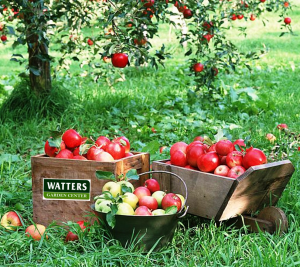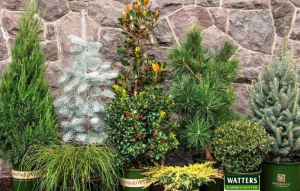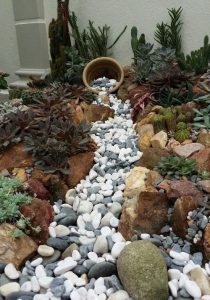You now have the three ideal trees for every mountain season. 
Spring Trees for the Landscape
Oklahoma Redbud grows just 16 feet tall. This local native is super easy to grow. Vibrant, red flowers cloak the branches of early spring. Luscious heart-shaped leaves emerge with a soft pink tinge that matures to a deep green. Plus, it’s small enough to grow in any yard.
Purple Robe Locust shows incredible, long clusters of purple flowers in May that look just like Wisteria flowers hanging from this local bloomer. The 8” fragrant clusters cover the tree profusely! Super hardy and drought tolerant with a brisk growth rate of 2’ feet in one year. It’s the perfect shade tree later in summer.
Thunder Cloud Plum is the perfect small purple tree between evergreens. Blooms in a profusion of pink flowers that precede the deep purple foliage. Large enough to use as a front yard tree and behaved enough to use as a street tree. Plant pairs flanking gateways, driveways or in orchard-like rows to screen a view of neighbors.
SUMMER Trees for the Landscape
Quaking Aspen has a tall, columnar form that provides excellent shade in small backyards or between homes at the edge of property lines. Perfect at shading scorching, sunbaked walls. They eventually grow tall enough to shade second-story decks. A valuable characteristic of aspens is that they don’t take over the yard after several years like many other fast-growing trees.
Sensation Maple is a stunning shade tree that thrives in severe garden conditions without skipping a beat. Faster growing, the spring leaves erupt in soft copper that quickly matures to a refreshing green with just a hint of copper undertones for the summer. Through autumn, it unleashes a brilliant display of red leaves. Where this tree really shines is in areas having challenging conditions. Once established, it is super drought tolerant. The perfect tree to line a long driveway or the picture-perfect patio shade tree.
Sunburst Honeylocust cheerfully shouts, “Hello, Spring!” with its glowing yellow leaves. As summer heats up, it settles down to a naturally cool green that turns gold again in autumn. This Watters exclusive casts a dappled shade perfect for reading a book or sharing an outdoor meal. It takes the sun and wind, yet is easy on your time, water and maintenance. Even the autumn cleanup is a piece of cake! Impervious to deer.
AUTUMN Trees for the Landscape
Prescott Blaze Maple flaunts fall color like embers in a blazing hot fire. It loves mountain soil, extreme conditions and takes our wind better than all other shade trees. It’s perfect for patios, hot sunny walls, street and driveway trees or any place shaded relief is needed.
Raywood Ash has the boldest fall foliage. The dark green summer leaves turn attractive wine-red through autumn. Plant as a single shade tree or grove for more widespread shade, especially on hotter south and west walls and patios. It is the perfect driveway-lining street tree that is both drought-hardy and beautiful.
Prescott Flowering Pear starts spring with dazzling white flowers. Summer shade is created by thick dark green foliage that is the last tree to turn brilliant red in fall. Even the winter bark is attractive. It’s the ideal specimen for lawns, lining driveways and standing alone as a model in small spaces. Even in the most challenging soil, this tree grows 30’x15’.
WINTER EVERGREEN Trees for the Landscape
Austrian Pine blocks the neighbors with a gorgeous evergreen tree! It is a handsome tree with a densely branched conical form when young and becomes umbrella-shaped with age. Needles are long and dark green. It is superb for windbreaks or as a single specimen. It is the fastest-growing local pine that quickly grows 40’ tall x 15’ wide.
Blue Spruce trees combine beauty and function. Their distinctive blue foliage is a stunning addition to any landscape and they grow tall enough to screen and create a wind break. Twice taller than wide, this native evergreen is best planted where it has room to grow. It can be used to separate tall multistory buildings and is tall enough to screen the view from second or third story windows. The blue spruce is gorgeous in estate-sized landscapes.
Vanderwolf Pine is related to Arizona Pinion Pine and produces fluffy foliage that resembles a blue cedar from a distance. It is remarkably resilient in dry Arizona soils and makes a graceful single specimen in front yards, parks or expansive, estate-sized landscapes. This distinctive pine grows 12’ x 5’ with long, twisted, silvery needles covering the dense branches. It is also carefree and easy to grow.
You now have the three ideal trees for every mountain season. The soil is warm and trees are actively rooting, making this an ideal season to plant new trees of your own. Research even more local choices through the web at Top10Trees.com.
Until next issue, I’ll be helping local gardeners plant the best trees here at Watters Garden Center. QCBN
By Ken Lain
Throughout the week, Ken Lain can be found at Watters Garden Center, 1815 W. Iron Springs Road in Prescott, or contacted through his website at WattersGardenCenter.com or Top10Trees.com.











